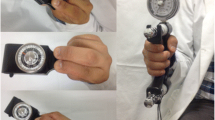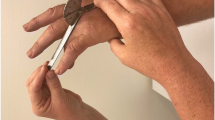Abstract
Introduction
Several studies have investigated the clinical outcome after collagenase treatment for Dupuytren’s disease in terms of range of motion of the affected finger. However, good objective clinical outcome defined by a small remaining flexion contracture does not necessarily translate into satisfactory patient-subjective hand function. The aim of the present study was to identify predictors of patient-reported as well as objective clinical outcome in patients 1 year after collagenase treatment for Dupuytren’s disease.
Materials and methods
Socio-demographic and disease-related data of 92 Dupuytren patients were collected prior to the intervention. Flexion contracture of the most affected finger was measured at baseline and 1 year after treatment. Patients also completed the brief Michigan Hand Outcomes Questionnaire (brief MHQ) before the intervention and at 1-year follow-up. First, univariate correlations using Pearson’s correlation coefficient of the baseline variables with the two target variables were investigated. All variables with r > 0.35 were selected for a multivariate linear stepwise backwards regression model.
Results
The mean brief MHQ score increased between baseline (72 ± 14) and the 1-year follow-up (85 ± 15) (p ≤ 0.001) and baseline flexion contracture decreased from 76° (± 26) to 33° (± 31) (p ≤ 0.001). Higher hand function at baseline (R2 = 0.31) and less flexion contracture (R2 = 0.46) were identified as positive predictors for the outcome 1 year after collagenase treatment for Dupuytren’s disease. Other variables such as age, gender, manual work and if the MCP or PIP joint was affected did not determine outcome in our patient series.
Conclusions
Collagenase treatment resulted in considerable improvement in flexion contracture as well as patient-reported hand function at the 1-year follow-up. Clinicians can expect better outcome after collagenase infiltration in patients with less flexion contracture and in patients showing good initial self-reported hand function.



Similar content being viewed by others
References
Wolfe S, Pederson W, Kozin S, Cohen M (2011) Green’s operative hand surgery, 6th edn. Elsevier, Amsterdam
Gilpin D, Coleman S, Hall S et al (2010) Injectable Collagenase Clostridium histolyticum: a new nonsurgical treatment for Dupuytren’s disease. J Hand Surg Am 35:2027–2038.e1
Bear BJ, Peimer CA, Kaplan FTD et al (2017) Treatment of recurrent dupuytren contracture in joints previously effectively treated with collagenase Clostridium histolyticum. J Hand Surg Am 42:391:e1–391.e8
Peimer CA, Blazar P, Coleman S et al (2013) Dupuytren contracture recurrence following treatment with collagenase Clostridium histolyticum (CORDLESS Study): 3-year data. J Hand Surg Am 38:12–22
Raven RB, Kushner H, Nguyen D et al (2014) Analysis of efficacy and safety of treatment with collagenase Clostridium histolyticum among subgroups of patients with Dupuytren contracture. Ann Plast Surg 73:286–290
Warwick D, Arner M, Pajardi G et al (2015) Collagenase Clostridium histolyticum in patients with Dupuytren’s contracture: results from POINT X, an open-label study of clinical and patient-reported outcomes. J Hand Surg Eur 40:124–132
Witthaut J, Jones G, Skrepnik N et al (2013) Efficacy and safety of collagenase Clostridium histolyticum injection for dupuytren contracture: short-term results from 2 open-label studies. J Hand Surg Am 38:2–11
Lipman MD, Carstensen SE, Deal DN (2017) Trends in the treatment of Dupuytren disease in the United States between 2007 and 2014. Hand 12:13–20. https://doi.org/10.1177/1558944716647101
Keller M, Arora R, Schmiedle G, Kastenberger T (2017) Treatment of Dupuytren’s disease with collagenase Clostridium histolyticum. Orthopade 46:321–327. https://doi.org/10.1007/s00132-017-3386-6
Van Beeck A, Van den Broek M, Michielsen M et al (2017) Efficacy and safety of collagenase treatment for Dupuytren’s disease: 2-year follow-up results. Hand Surg Rehabil 36:346–349
McMillan C, Yeung C, Binhammer P (2017) Variation in treatment recommendations for Dupuytren disease. J Hand Surg Am 42:963–970.e6. https://doi.org/10.1016/j.jhsa.2017.08.023
Degreef I, Vererfve PB, De Smet L (2009) Effect of severity of Dupuytren contracture on disability. Scand J Plast Reconstr Surg Hand Surg 43:41–42. https://doi.org/10.1080/02844310802410125
Zyluk A, Jagielski W (2007) The effect of the severity of the Dupuytren’s contracture on the function of the hand before and after surgery. J Hand Surg Eur 30:326–329
Tsai T, Orav J, Jha A (2015) Patient satisfaction and quality of surgical care in US hospitals. Ann Surg 261:2–8
Engstrand C, Krevers B, Kvist J (2015) Factors affecting functional recovery after surgery and hand therapy in patients with Dupuytren’s disease. J Hand Ther 28:255–260
Zhou C, Hovius SER, Slijper HP et al (2016) Predictors of patient satisfaction with hand function after fasciectomy for Dupuytren’s contracture. Plast Reconstr Surg 138:649–655
Bradley J, Warwick D (2016) Patient satisfaction with collagenase. J Hand Surg Am 41:689–697
Scherman P, Jenmalm P, Dahlin LB (2016) One-year results of needle fasciotomy and collagenase injection in treatment of Dupuytren’s contracture: a two-centre prospective randomized clinical trial. J Hand Surg Eur 41:577–582. https://doi.org/10.1177/1753193415617385
Haase S, Chung K (2018) Bringing it all together. Hand Clin 34:427–436
Ball C, Pratt AL, Nanchahal J (2013) Optimal functional outcome measures for assessing treatment for Dupuytren’s disease: a systematic review and recommendations for future practice. BMC Musculoskelet Disord 14:131
Knobloch K, Kraemer R, Papst S et al (2012) German version of the brief Michigan hand outcomes questionnaire: implications for early quality of life following collagenase injection in Dupuytren contracture. Plast Reconstr Surg 129:886–887
Waljee J, Kim M, Burns P, Chung K (2011) Development of a brief, 12-item version of the Michigan Hand Questionnaire. Plast Reconstr Surg 128:208–220
McMillan CR, Binhammer PA (2009) Which outcome measure is the best? Evaluating responsiveness of the disabilities of the arm, shoulder, and hand questionnaire, the Michigan hand questionnaire and the patient-specific functional scale following hand and wrist surgery. Hand 4:311–318
Taylor J (1990) Interpretation of the correlation coefficient: a basic review. J Diagn Med Sonogr 6:35–39
Descatha A, Jauffret P, Chastang JF et al (2011) Should we consider Dupuytren’s contracture as work-related? A review and meta-analysis of an old debate. BMC Musculoskelet Disord 12:96
Logan AJ, Mason G, Dias J, Makwana N (2005) Can rock climbing lead to Dupuytren’s disease? Br J Sports Med 39:639–644
Legge, JWHMcFarelane RM (1980) Prediction of results of treatment of Dupuytren’s disease. J Hand Surg Am 5:608–616
Melamed E, Beutel BG, Goldstein S, Angel D (2017) Predictors of outcomes following fasciectomy for Dupuytren’s disease in diabetic and non-diabetic patients. J Hand Surg 22:309–314
Acknowledgements
We would like to thank Martina Wehrli for her assistance during data collection and Dr Melissa Wilhelmi for manuscript editing.
Funding
This research received no specific grant from any funding agency in the public, commercial, or not-for-profit sectors.
Author information
Authors and Affiliations
Corresponding author
Ethics declarations
Conflict of interest
M. Calcagni has received sponsoring from SOBI for an event on Dupuytren treatment. All other authors have no conflict of interest to declare.
Ethical approval
All procedures performed in studies involving human participants were in accordance with the ethical standards of the institutional and/or national research committee and with the 1964 Helsinki declaration and its later amendments or comparable ethical standards.
Informed consent
Patient informed consent was obtained from all individual participants included in the study.
Rights and permissions
About this article
Cite this article
Scheibler, AG., Marks, M., Hensler, S. et al. Factors predicting the 1-year outcome of collagenase treatment for Dupuytren’s disease. Arch Orthop Trauma Surg 139, 583–588 (2019). https://doi.org/10.1007/s00402-019-03120-y
Received:
Published:
Issue Date:
DOI: https://doi.org/10.1007/s00402-019-03120-y




